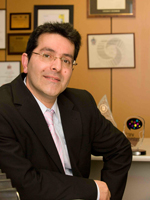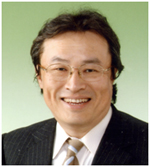Keynote Speakers
We are very pleased to have acquired the services of an excellent selection of keynote speakers for KES2010. The speakers and the titles of their talks are shown below.
Christopher Bishop
Microsoft Research Cambridge, UKEmbracing Uncertainty: the New Machine Intelligence
More details ...
Nikola Kasabov
University of Technology, Auckland, New ZealandEvolving Integrative Brain-, Gene-, and Quantum Inspired Systems for Computational Intelligence and Knowledge Engineering
More details ...
Saeid Nahavandi
Centre for Intelligent Systems Research, Deakin University - Victoria, AustraliaKnowledge Visualisation for Engineered Systems
More details ...
Tetsuo Sawaragi
Kyoto University, JapanA Semiotic View of Social Intelligence for Realizing Human-Machine Symbiotic Systems
More details ...
Yuzuru Tanaka
Hokkaido University, JapanProximity-based Federation of Smart Objects: Liberating Ubiquitous Computing from Stereotyped Application Scenarios
More details ...
Roger Whitaker
Cardiff University, UKExploiting Social Structures and Social Networks
More details ...
Christopher Bishop
Microsoft Research Cambridge, UKEmbracing Uncertainty: the New Machine Intelligence
Abstract:
Many of the early applications of machine intelligence were based on expert systems constructed using rules elicited from human experts. Limitations in the applicability of this approach helped to drive black-box statistical methods, such as neural networks, based on learning from data. These black-box methods too are hitting limitations, due to the challenges of incorporating background knowledge. In this talk I will describe a new paradigm for machine intelligence which has emerged over the last five years, and which allows prior knowledge from domain experts to be integrated with machine learning techniques to enable a new generation of large-scale applications. The talk will be illustrated with tutorial examples as well as real-world case studies.

Biography:
Chris Bishop is the Chief Research Scientist at Microsoft Research Cambridge. He is also Professor of Computer Science at the University of Edinburgh, and a Fellow of Darwin College, Cambridge. He has been elected a Fellow of the Royal Academy of Engineering, and a Fellow of the Royal Society of Edinburgh. He is the author of the leading textbook "Pattern Recognition and Machine Learning" (Springer, 2006). In 2008 he presented the 180th Royal Institution Christmas Lectures, with the title Hi-tech Trek: The Quest for the Ultimate Computer, which were broadcast at prime time on UK national television.
Nikola Kasabov
University of Technology, Auckland, New ZealandEvolving Integrative Brain-, Gene-, and Quantum Inspired Systems for Computational Intelligence and Knowledge Engineering
Abstract:
The talk presents theoretical foundations and practical applications of evolving intelligent information processing systems inspired by information principles in Nature in their interaction and integration. That includes neuronal-, genetic-, and quantum information principles, all manifesting the feature of evolvability. First, the talk reviews the main principles of information processing at neuronal-, genetic-, and quantum information levels. Each of these levels has already inspired the creation of efficient computational models that incrementally evolve their structure and functionality from incoming data and through interaction with the environment. The talk also extends these paradigms with novel methods and systems that integrate these principles. Examples of such models are: evolving spiking neural networks; computational neurogenetic models (where interaction between genes, either artificial or real, is part of the neuronal information processing); quantum inspired evolutionary algorithms; probabilistic spiking neural networks utilizing quantum computation as a probability theory. The new models are efficient in feature selection and learning and facilitate representing uncertainty in problems and the discovery of new knowledge. They can be applied to solving efficiently complex biological and engineering problems for adaptive, incremental learning and knowledge discovery in large dimensional spaces and in a new environment, such as: on-line multimodal audiovisual information processing; bioinformatics and neuroinformatics; biomedical decision support systems; cyber-security. Open questions, challenges and directions for further research are presented.
References
[1] N.Kasabov (2007) Evolving Connectionist Systems: The Knowledge Engineering Approach, Springer, London (www.springer.de)
[2] N.Kasabov, Evolving Intelligence in Humans and Machines: Integrative Connectionist Systems Approach, Feature article, IEEE CIS Magazine, August, 2008, vol.3, No.3, www.ieee.cis.org, pp. 23-37
[3] N.Kasabov, Integrative Connectionist Learning Systems Inspired by Nature: Current Models, Future Trends and Challenges, Natural Computing, Springer, Vol. 8, 2009, Issue 2, pp. 199-210,
[4] N.Kasabov, To spike or not to spike: A probabilistic spiking neural model, Neural Networks, Volume 23, Issue 1, January 2010, Pages 16-19

Biography:
Professor Nikola Kasabov is the Director and Founder of the Knowledge Engineering and Discovery Research Institute (KEDRI), Auckland. He holds a Chair of Knowledge Engineering at the School of Computing and Mathematical Sciences at Auckland University of Technology. He is a Fellow of IEEE, Fellow of the Royal Society of New Zealand and Fellow of the New Zealand Computer Society. He is the President of the International Neural Network Society (INNS) and a Past President of the Asia Pacific Neural Network Assembly (APNNA). He is a member of several technical committees of IEEE Computational Intelligence Society and IFIP. Kasabov has served as Associate Editor of Neural Networks, IEEE TrNN, IEEE TrFS, Information Science, J. Theoretical and Computational Nanosciences, Applied Soft Computing and other journals. Kasabov holds MSc and PhD from the Technical University of Sofia, Bulgaria. His main research interests are in the areas of intelligent information systems, soft computing, neuro-computing, bioinformatics, neuroinformatics, novel methods for data mining and knowledge discovery. He has published more than 420 publications that include 15 books, 120 journal papers, 60 book chapters, 32 patents and numerous conference papers. He has extensive academic experience at various academic and research organisations: University of Otago, New Zealand; University of Essex, UK; University of Trento, Italy; Technical University of Sofia, Bulgaria. Recently he has been elected Guest Professor at Shanghai Jiao Tong University. Prof. Kasabov has received the Bayer Science Innovation Award, the RSNZ Science and Technology Silver Medal, the APNNA Excellent Service Award and other awards. More information of Prof. Kasabov can be found on the KEDRI web site: http://www.kedri.info.
Saeid Nahavandi
Centre for Intelligent Systems Research, Deakin University - Victoria, AustraliaKnowledge Visualisation for Engineered Systems
Abstract:
In this information age computer modelling and simulation is proving an indispensable tool for system design, operation, analysis, decision-making, optimisation, education and training. World leading operations are increasingly relying on modelling and simulation to develop more efficient systems and to produce higher quality products and services. Modelling and simulation allows scientists and engineers a better understanding of three-dimensional and time-dependent phenomena, as well as providing a platform for predicting future behaviour. This talk will focus on the challenges associated with the modelling and simulation of engineered systems and discuss how knowledge visualisation can provide effective communication to various levels of organisational management.

Biography
Saeid Nahavandi is Alfred Deakin Professor and the Director for the Centre for Intelligent Systems Research at Deakin University in Australia.
Saeid is a graduate of Durham University in the UK. He is a Fellow member of IET, IEAust and Senior Member of IEEE.
Professor Nahavandi has published over 350 refereed papers and been awarded several competitive Australian Research Council (ARC) grants in the past five years. He received the Research collaboration / initiatives award from Japan (2000) and Prince & Princess of Wales Science Award in 1994. He won the title of Young Engineer of the Year Award in 1996 and holds two patents. In 2002 Professor Nahavandi served as a consultant to Jet Propulsion Lab (NASA) during his visit to JPL Labs. In 2006 he received the title of Alfred Deakin Professor, the highest honour at Deakin University for his contribution to fundamental research.
Professor Nahavandi is the founder for the Centre for Intelligent Systems Research with 55 full time researchers at Deakin University. He actively contributes and leads four major research projects in three Cooperative Research Centres with over 50 major international companies as partners. In modelling and simulation of complex systems he received awards from several organisations to focus on simulation based optimization of manufacturing processes, airport operations, logistics and distribution centres. He has carried out industry based research with several major international companies such as GM, Ford, Nissan, Bosch, Futuris, Boeing, Vestas just to name a few. For his contribution in haptics and robotics he won two major research grants from the Australian Department of Defence on haptically enabled counter explosive robot design.
Professor Nahavandi has been the chairman of six International conferences and the General Chair for World Manufacturing Congress series and the International Congress on Autonomous Intelligent Systems. He also holds the position of Editor for the International Journal Intelligent Automation and Soft Computing (South Pacific region), International Journal of Computational Intelligence and Associate Editor - IEEE Systems Journal.
Tetsuo Sawaragi
Kyoto University, JapanA Semiotic View of Social Intelligence for Realizing Human-Machine Symbiotic Systems
Abstract:
In a coming ubiquitous society, the collaboration between the human and the semi-automated machine is inevitable. The core difficulty herein is that cognitive agents (i.e., human and robot) are characterized as creative and adaptable to and within their environments. To tackle this problem, we have to clarify how the cognitive agent recognizes the external environment as well as other agents' behavioural performances, and how the context determines their cognition and makes the agent extract a particular meaning out of the physical and/or social environment. In this talk, we focus on the design issues of the mutual and inseparable relationships between the external environment including others and the internal constructs of the agent that is an actor, an observer, a cognizer, and an interpreter. For this purpose, we introduce the subject of "semiosis", which is any form of activity, conduct, or process that involves signs, including the production of meanings. After reviewing the original idea of Peirce's semiosis, our extended definition of the semiosis will be provided. That is, we define semiosis as "a process of constructing internal models within the cognitive agent" coherent to a target system in the environment to use, to monitor, to control, to collaborate with, etc. Based upon this, the research can be divided into the following thee kinds of topics. The first one is on the semiotic analysis of the complex behaviours of the existing artefact systems and of the complex tasks that the user is forced to perform and to be instructed by some others. The second one is on the semiotic design of artefacts so that they should be coherent to cognitive agents recognition, wherein the targets to be designed are focused on "signs" that are visible and eligible to the cognitive agents either directly or via interface systems. Finally, the third one is on the design of collaborative activities by a pair of cognitive agents (i.e., teaching tasks and/or learning tasks) via a variety of signs. With respect to this, the design and communication issues of human-centered automation and of ambient intelligence will be discussed in terms of the semiotic frame. This work is fully supported by a Grant-in-Aid Creative Scientific Research 2007-2011 (19GS0208) funded by the Ministry of Education, Culture, Sports, Science and Technology, Japan.

Biography:
Tetsuo Sawaragi was born in 1957 and is now a professor at the Dept. of Mechanical Engineering and Science, Graduate School of Engineering, Kyoto University, Japan. He received his B.S., M.S. and Ph.D. degrees in Systems Engineering from Kyoto University in 1981, 1983 and 1988, respectively. From 1986 to 1994, he was a research associate at the Department of Precision Mechanics, Faculty of Engineering, Kyoto University, wherein he was an associate professor and a professor in 1994 and 2002, respectively. In 2005 he was in the current department as a professor, and is presently an assistant to executive vice-president and a director of Center for Global Leadership Engineering Education (CGLEE) of Kyoto University. From 1991 to 1992, he was a visiting scholar at Dept. of Engineering-Economic Systems, Stanford University, USA. He has been engaged in the researches on Systems Engineering, Cognitive Science and Artificial Intelligence, particularly in the development of human-machine collaborative systems, modeling the transfer of human cognitive skills into machines. He was a chair of IEEE SMC Japan Chapter and a board member of the Institute of Systems, Control and Information Engineers, Human Interface Society and Japan Society for Fuzzy Theory and Systems. He was a project leader of the 21st Century COE Program "Center of Excellence for Research and Education on Complex Functional Mechanical Systems" of Kyoto University, and is currently a principal investigator of the Grant-in-Aid Creative Scientific Research 2007-2011 (19GS0208) on "Design Theory for Dynamical Systems with Semiosis" that is funded by the Ministry of Education, Culture, Sports, Science and Technology and is ongoing mainly at Kyoto University. He is a former president of Human Interface Society.
Yuzuru Tanaka
Hokkaido University, JapanProximity-based Federation of Smart Objects: Liberating Ubiquitous Computing from Stereotyped Application Scenarios
Abstract:
Information system environments today are rapidly expanding their scope of subject resources, their geographical distribution, their reorganization, and their advanced utilization. Currently, this expansion is understood only through its several similar but different aspects, and referred to by several different stereotyped terms such as ubiquitous computing, pervasive computing, mobile computing, and sensor networks. No one has clearly defined this expansion as a whole. In such an environment, some resources are accessible through the Web, while others are accessible only through peer-to-peer ad hoc networks. Recently it is often pointed out that the lack of a formal computing model to cover this diversity as a whole is the main reason why most applications of ubiquitous computing today are still within the scope of the two stereotyped scenarios, i.e., the location-transparent service continuation, and the location- and/or situation-aware service provision. This talk will focus on the ad hoc federation of intellectual resources on smart objects. It first reviews our formal model of autonomic proximity-based federation among smart objects including both physical smart objects with wireless network connectivity and virtual smart objects such as services on the Web. Then it proposes some application frameworks based on this model. Smart objects here denote computing devices such as RFID tag chips, smart chips with sensors and/or actuators, mobile PDAs, intelligent electronic appliances, embedded computers, and access points with network servers. Each smart object is modeled as a set of ports, each of which represents an I/O interface for a function of this smart object. Here, we consider the matching of service-requesting queries and service-providing capabilities that are respectively represented as service-requesting ports and service-providing ports. In the preceding research studies, federation mechanisms were based on the matching of a service requesting message with a service-providing message. They were not independent from the codes defining the behavior of the smart objects. Our abstract model allows us to discuss applications from the view point of their federation structures. This enables us to extract a common substructure from similar applications as an application framework. This talk will show how our formal model of federation enables us to describe application frameworks not only for stereotyped applications, but also novel applications, including those inspired by molecular biological mechanisms.

Biography:
Yuzuru Tanaka has been a full professor of computer architecture at the Department of Electrical Engineering (1990-2003), then of knowledge media architecture at the Department of Computer Science, Graduate School of Information Science and Technology (2004- ), Hokkaido University, and the director of Meme Media Laboratory (1995- ), Hokkaido University. He was also a full professor of Digital Library, Graduate School of Informatics, Kyoto University (1998-2000), and has been an adjunct professor of National Institute of Informatics (2004- ). His research areas covered multiprocessor architectures, database schema-design theory, hardware algorithms for searching and sorting, multiport memory architectures, database machine architectures, full text search of document image files, and automatic cut detection in movies and full video search. His current research areas cover meme media architectures, knowledge federation frameworks, proximity-based federation of smart objects, and their application to digital libraries, e-Science and clinical trials. He worked as a visiting research fellow at IBM T.J. Watson Research Center (1985-1986), a board member(1991-1994) and a councillor (1995- ) of Japanese Society for Artificial Intelligence, a fellow and a board member of Information Processing Society of Japan (1995-1996, 1999-2000, 2008-2009), a fellow and a councillor of Japanese Society of Software Science, an associate member of Japanese Academy of Science (2006-2007), and an advisory board member of NTT Research Laboratory (2004- ). He has been involved in EU's FP6 Integrated Project ACGT (Advancing Clinico-Genomic Trials on Cancer), and FP7 Best Practice Network Project ASSETS (Advanced Search Services and Enhanced Technological Solutions for the European Digital Library).
Roger Whitaker
Cardiff University, UKExploiting Social Structures and Social Networks
Abstract:
In recent years there has been much recent interest in the use of online social networks for maintaining and building relationships with others. In this talk we explore some of the key characteristics of social networks and how they can potentially be exploited to provide intelligent content sharing in the pervasive and mobile computing domain.
Wireless and mobile devices such as phones, MP3 players, sensors, phones and PDAs are becoming increasingly capable of creating and sharing content. Harnessing this across devices that are only intermittently connected requires new adaptive approaches to networking and may facilitate new future applications. The basis for intermittent or temporary connectivity directly between devices, known as opportunistic networking, allows wireless devices to store, carry and forward information between themselves. In this talk we show how devices can build up, detect and potentially exploit social structures to fulfill functions such as community detection, cooperation, trust and content sharing between peers that may repeatedly interact with each other on a local basis. We also show how this technology may emerge in future applications. Coordinated by the School of Informatics at Cardiff University, this work is supported by the EC FP7 SOCIALNETS project, funded under the Future emerging technologies programme in collaboration with University of Cambridge (UK), University of Oxford (UK), CNR (Italy), Eurecom (France), University of Athens (Greece) and University of Aveiro (Portugal). See: http://www.social-nets.eu/

Biography:
Roger Whitaker is Head of the Cardiff School of Computer Science and Informatics. His personal research focuses on the intelligent design and use of networks for content provision. This involves a range of areas including:
intelligence: meta-heuristics, agents, emergent behaviour, cognitive processes;
content provision: cooperation, trust, relevance, social networks, geo-spatial information;
mobile and pervasive technologies: 2G, 3G and 4G systems, peer-to-peer networks, opportunistic networks.
These activities are inherently interdisciplinary and involve considerable collaboration with a range of other subjects. Roger has previously worked on optimisation for cellular network design and was co-recipient of a Cardiff University Innovation award for contributions to commercialised network design software. He is coordinator for the EC FP7 SOCIALNETS project and forthcoming RECOGNITION project, both funded under the Future Emerging Techologies programme for high adventure research. His current research is also supported by EPSRC and BT plc, building on past collaborations with Ofcom and BAe Systems. He is associate editor for Wireless Networks and Telecommunication Systems (Springer).




